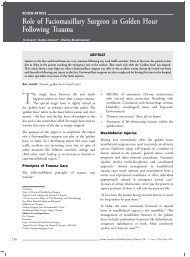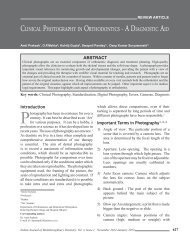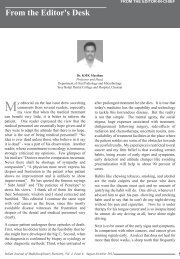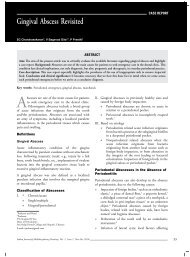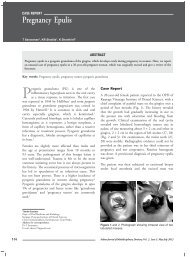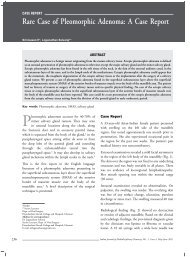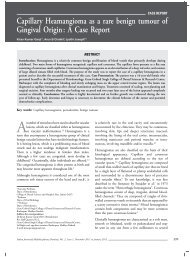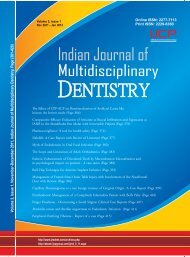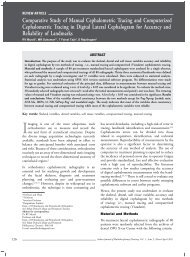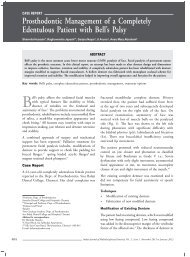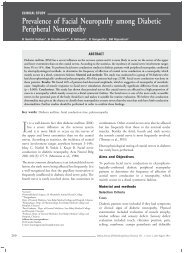Volume 2 - Issue 2 - IJMD
Volume 2 - Issue 2 - IJMD
Volume 2 - Issue 2 - IJMD
- No tags were found...
You also want an ePaper? Increase the reach of your titles
YUMPU automatically turns print PDFs into web optimized ePapers that Google loves.
case reportA Variant of Monostotic Craniofacial Type ofFibrous Dysplasia – A Rare Case ReportVennila P*, Chandrasekar T**, Sheetal S Menon †AbstractFibrous dysplasia is an uncommon, sporadic skeletal disorder characterized by proliferation with secondary bony metaplasia,producing immature, newly formed and weakly calcified bone, without maturation of osteoblasts, typically presenting infirst or second decade of life and then slowly progressing until the patient reaches the age of thirty years. The aim of thispresentation is to represent a rare case of monostotic craniofacial fibrous dysplasia, in a 55 year old male, which is a goodexample of somatic mosaicism in which a wide spectrum of disease is possible.Key words: Fibrous dysplasia, sporadic, metaplasia, osteoblasts, monostotic, somatic mosaicismFibrous dysplasia is a bone development anomalycharacterised by hamartoma proliferation offibrous tissue within the medullary bone, withsecondary bony metaplasia, producing immature,newly formed and weakly calcified bone, withoutmaturation of osteoblast which appears radiolucenton radiographs, with classically described groundglass appearance. 1 Fibrous dysplasia is described interms of three major types, monostotic involving asingle bone, polyostotic involving multiple bonesand Mc Cune-Albright syndrome, a polyostoticform of fibrous dysplasia that also involves endocrineabnormalities. 2 Fibrous dysplasia was first reported byVon Recklinghausen in 1891 and he coined the termOsteitis Fibrosa Generalisata. In 1938, Lichtensteinand Jaffe first introduced the term Fibrous dysplasia.In this paper, we describe a variant of monostoticcraniofacial fibrous dysplasia. This case is interestingfor its unusual features and to our knowledge is thefirst of its kind to be reported.Case ReportA 55- year- old male, presented to the Department ofOral Medicine and Radiology, Sri Ramakrishna DentalCollege and Hospital, Coimbatore, Tamil Nadu, with*Senior lecturer, Dept. of Oral Medicine and Radiology**Professor and Head of the Dept.†BDSDept. of Oral Medicine and RadiologySri Ramakrishna Dental College and Hospital, Coimbatore - 641006Address for correspondenceDr Vennila P, MDSE-mail: velsdentcare@yahoo.comthe chief complaint of pain on the left side of the facefor the past 8 days. The patient had associated swellingon the same side for the past 5 years. The swelling wasinitially asymptomatic and it gradually increased in size.It was also associated with discharge of pus which wasevident on the left side of the mandible. Past medical anddental history were not contributory. There was no familyhistory with similar findings.General examination showed no abnormalities. On extraoral examination, gross facial asymmetry was noted dueto the presence of a diffused swelling on the left side ofthe face, extending anteriorly from the midline crossing33, posteriorly to the tragus of the ear, superiorly fromcondyle and inferiorly to angle of the mandible. Therewas draining sinus in the body of the mandible on theleft side. On intraoral examination, a unilateral diffuseexpansile mass was seen on the alveolar ridge on the leftside. It was tender and hard in consitency. On hard tissueexamination, there was generalized severe attrition. Basedon the clinical examination, the initial diagnosis was a fibroosseous lesion of the mandible with periapical pathologyleading to a sinus opening.On further investigation, the occlusal radiograph revealed aunilateral expansile mass of mixed radiolucency. Bicorticalexpansion was seen on the left side of the mandible. OPGrevealed a well defined mixed radiolucent and radiopacitieson the left side of the mandible, extending from left lowercanine 33 to the condyle on the same side. There was alsodisplacement of teeth and associated resorption of roots.CT Scan showed gross expansion with areas of sclerosisand lucencies seen in the left ramus and adjacent body of460Indian Journal of Multidisciplinary Dentistry, Vol. 2, <strong>Issue</strong> 2, February-April 2012



